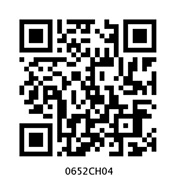Table of Contents
4
Sorting Materials into Groups
4.1 Objects Around us
We have seen that our food and clothes have so much variety in them. Not just food and clothes, there is such a vast variety of objects everywhere. We see around us, a chair, a bullock cart, a cycle, cooking utensils, books, clothes, toys, water, stones and many other objects. All these objects have different shapes, colours and uses (Fig. 4.1).
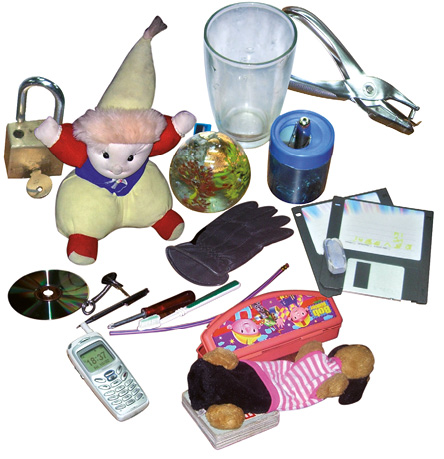
Look around and identify objects that are round in shape. Our list may include a rubber ball, a football and a glass marble. If we include objects that are nearly round, our list could also include objects like apples, oranges, and an earthen pitcher (gharha). Suppose we were looking for objects that are edible. We might include all the items that we have listed in Tables 1.1, 1.2 and 1.3 in Chapter 1. We might also find that some of those round shaped objects we just listed out, are also in this group.
Let us say, we wish to make a group of objects that are made of plastics. Buckets, lunch boxes, toys, water containers, pipes and many such objects, may find a place in this group. There are so many ways to group objects! In the above examples we have grouped objects on the basis of their shape or the materials they are made from.
All objects around us are made of one or more materials. These materials may be glass, metal, plastics, wood, cotton, paper, mud or soil. Can you think of more examples of materials?
Activity 1
Let us collect as many objects as possible, from around us. Each of us could get some everyday objects from home and we could also collect some objects from the classroom or from outside the school. What will we have in our collection? Chalk, pencil, notebook, rubber, duster, a hammer, nail, soap, spoke of a wheel, bat, matchbox, salt, potato. We can also list objects that we can think of, but, cannot bring to the classroom. For example, wall, trees, doors, tractor, road.
Separate all objects from this collection that are made from paper or wood. This way we have divided all objects into two groups. One group has the objects that are made from paper or wood while the other group has the objects that are not made of these materials. Similarly, we could separate the things that are used for preparing food.
Let us be a little more systematic. List all objects collected, in Table 4.1. Try to identify the materials that each one is made of. It would be fun to make this a large table – collecting information about as many objects as possible. It may seem difficult to find out the materials out of which some of these objects are made. In such cases, discuss with your friends, teacher and parents to identify the materials.
Table 4.1 Objects and the materials they are made of
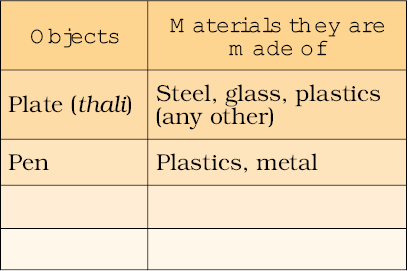
Activity 2
Table 4.2 lists some common materials. You can also add more materials in Column 1 that are known to you. Now, try and think of everyday objects you know, that are made mainly of these materials, and list them in Column 2.

Table 4.2 Different types of objects that are made from the same material
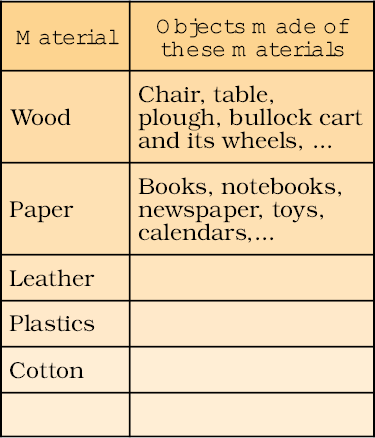
What do we find from these tables? First, we grouped objects in many different ways. We then found that objects around us are made of different materials. At times, an object is made of a single material. An object could also be made of many materials. And then again, one material could be used for making many different objects. What decides which material should be used for making any given object? It seems that we need to know more about different materials.
4.2 Properties of Materials
Have you ever wondered why a tumbler is not made with a piece of cloth? Recall our experiments with pieces of cloth in Chapter 3 and also keep in mind that we generally use a tumbler to keep a liquid. Therefore, would it not be silly, if we were to make a tumbler out of cloth (Fig 4.2)! What we need for a tumbler is glass, plastics, metal or other such material that will hold water. Similarly, it would not be wise to use paper-like materials for cooking vessels.
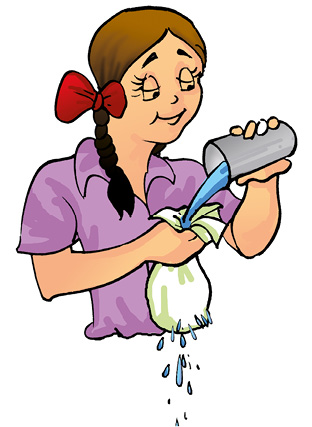
Fig. 4.2 Using a cloth tumbler
We see then, that we choose a material to make an object depending on its properties, and the purpose for which the object is to be used.
So, what are all the properties of materials that would be important for their usage? Some properties are discussed here.
Appearance
Materials usually look different from each other. Wood looks very different from iron. Iron appears different from copper or aluminium. At the same time, there may be some similarities between iron, copper and aluminium that are not there in wood.
Activity 3
Collect small pieces of different materials – paper, cardboard, wood, copper wire, aluminium sheet, chalk. Do any of these appear shiny? Separate the shiny materials into a group.
Now, observe as the teacher cuts each material into two pieces and look at the freshly cut surface (Fig. 4.3). What do you notice? Does the freshly cut surface of some of these materials appear shiny? Include these objects also in the group of shiny materials.
Do you notice such a shine or lustre in the other materials, cut them anyway as you can? Repeat this in the class with as many materials as possible and make a list of those with and without lustre. Instead of cutting, you can rub the surface of material with sand paper to see if it has lustre.

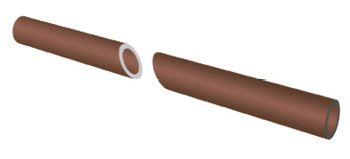
Fig. 4.3 Cutting pieces of materials to see if they have lustre
Materials that have such lustre are usually metals. Iron, copper, aluminium and gold are examples of metals. Some metals often lose their shine and appear dull, because of the action of air and moisture on them. We therefore, notice the lustre, only on their freshly cut surface. When you visit an ironsmith or a workshop, look out for freshly cut surfaces of metal rods to see if they have lustre.
Hardness
When you press different materials with your hands, some of them may be hard to compress while others can be easily compressed. Take a metal key and try to scratch with it, the surface of a piece of wood, aluminium, a piece of stone, a nail, candle, chalk, any other material or object. You can easily scratch some materials, while some cannot be scratched so easily. Materials which can be compressed or scratched easily are called soft while some other materials which are difficult to compress are called hard. For example, cotton or sponge is soft while iron is hard.
In appearance, materials can have different properties, like lustre, hardness, be rough or smooth. Can you think of other properties that describe the appearance of a material?
Soluble or Insoluble?
Activity 4
Collect samples of some solid substances such as sugar, salt, chalk powder, sand and sawdust. Take five glasses or beakers. Fill each one of them about two-thirds with water. Add a small amount (spoonful) of sugar to the first glass, salt to the second and similarly, add small amounts of the other substances into the other glasses. Stir the contents of each of them with a spoon. Wait for a few minutes. Observe what happens to the substances added to water (Fig. 4.4). Note your observations as shown in Table 4.3.
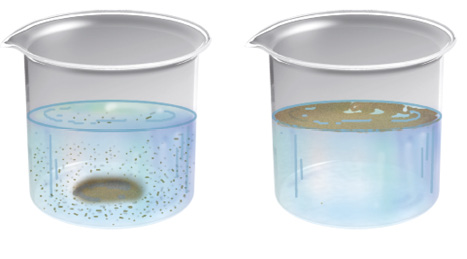
Fig. 4.4 What disappears, what doesn’t?
Table 4.3 Mixing different solid materials in water
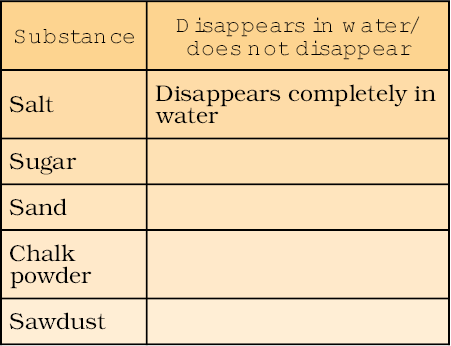
You will notice that some substances have completely disappeared or dissolved in water. We say that these substances are soluble in water. Other substances do not mix with water and do not disappear even after we stir for a long time. These substances are insoluble in water.
Water plays an important role in the functioning of our body because it can dissolve a large number of substances. Do liquids also dissolve in water?
Activity 5
Collect samples of vinegar, lemon juice, mustard oil or coconut oil, kerosene or any other liquid. Take a glass tumbler. Fill it up to half with water. Add a few spoonfuls of one liquid to this and stir it well. Let it stand for five minutes. Observe whether the liquid mixes with water (Fig. 4.5). Repeat the same with other liquids, as many different liquids as are available to you. Write your observations in Table 4.4.
Table 4.4 Solubility of some common liquids in water
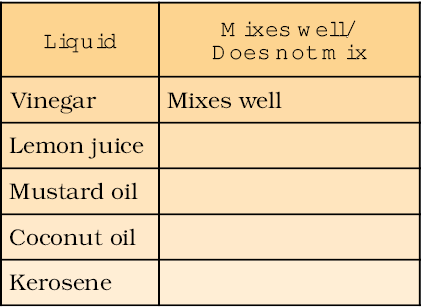

We notice that some liquids get completely mixed with water. Some others do not mix with water and form a separate layer when kept aside for some time.

Some gases are soluble in water whereas others are not. Water, usually, has small quantities of some gases dissolved in it. For example, oxygen gas dissolved in water is very important for the survival of animals and plants that live in water.
Objects may float or sink in water
While doing Activity 4, you might have noticed that the insoluble solids separated out from water. You may have also noticed this with some liquids in Activity 5. Some of these materials that did not mix with water, floated to the surface of water. Others may have sunk to the bottom of the tumbler, right? We notice many examples of objects that float in water or sink (Fig. 4.6). Dried leaves fallen on the surface of a pond, a stone that you throw into this pond, few drops of honey that you let fall into a glass of water. What happens to all
of these?
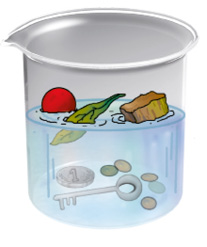
Figure 4.6 Some objects float in water while others sink in it
Boojho would like you to give him five examples each, of objects that float and those that sink in water. What about testing these same materials to see if they float or sink in other liquids like oil?
Transparency
You might have played the game of hide and seek. Think of some places where you would like to hide so that you are not seen by others. Why did you choose those places? Would you have tried to hide behind a glass window? Obviously not, as your friends can see through that and spot you. Can you see through all the materials? Those substances or materials, through which things can be seen, are called transparent (Fig. 4.7). Glass, water, air and some plastics are examples of transparent materials. Shopkeepers usually prefer to keep biscuits, sweets and other eatables in transparent containers of glass or plastic, so that buyers can easily see these items (Fig. 4.8).

Fig. 4.7 Looking through opaque, transparent or translucent material
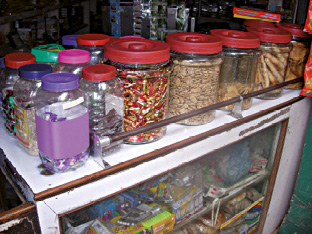
Fig. 4.8 Transparent bottles in a shop
On the other hand, there are some materials through which you are not able to see. These materials are called opaque. You cannot tell what is kept in a closed wooden box, a cardboard carton or a metal container. Wood, cardboard and metals, are examples of opaque materials.
Do we find that we can group all materials and objects, without any confusion, as either opaque or transparent?
Activity 6
Take a sheet of paper and look through it towards a lighted bulb. Make a note of your observation. Now, put 2-3 drops of some oil and spread it on the sheet of paper. Look again towards the lighted bulb through that portion of the paper on which the oil has been spread. Do you find that the bulb is more clearly visible than before? But, can you see clearly through the oiled paper? Is everything on the other side of it visible? Perhaps not. The materials through which objects can be seen, but not clearly, are known as translucent. Remember the oily patch on paper when we tested food items for presence of fats? That was translucent too. Can you think of some more examples of translucent materials?We can therefore group materials as opaque, transparent and translucent.

Paheli suggests covering the glass of a torch with your palm at a dark place. Switch on the torch and observe the other side of the palm. She wants to know whether palm of your hand is opaque, transparent or translucent?We learnt that materials differ in their appearance and the way they mix in water or other liquids. They may float or sink in water or may be transparent, opaque or translucent. Materials can be grouped on the basis of similarities or differences in their properties.
Why do we need to group materials? In everyday life, we often group materials for our convenience. At home, we usually store things in such a manner that similar objects are placed together. Such an arrangement helps us to locate them easily. Similarly, a grocer usually keeps all type of biscuits at one corner of his shop, all soaps at another while grains and pulses are stored at some other place.
There is another reason why we find such grouping useful. Dividing materials in groups makes it convenient to study their properties and also observe any patterns in these properties. We will study more about this in higher classes.
KeyWords
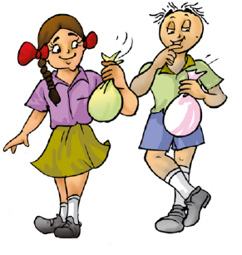
Summary
- Objects around us are made up of a large variety of materials.
- A given material could be used to make a large number of objects. It is also possible that an object could be made of a single material or of many different types of materials.
- Different types of materials have different properties.
- Some materials are shiny in appearance while others are not. Some are rough, some smooth. Similarly, some materials are hard, whereas some others are soft.
- Some materials are soluble in water whereas some others are insoluble.
- Some materials such as glass, are transparent and some others such as wood and metals are opaque. Some materials are translucent.
- Materials are grouped together on the basis of similarities and differences in their properties.
- Things are grouped together for convenience and to study their properties.
Exercises
1. Name five objects which can be made from wood.
2. Select those objects from the following which shine:
Glass bowl, plastic toy, steel spoon, cotton shirt
3. Match the objects given below with the materials from which they could be made. Remember, an object could be made from more than one material and a given material could be used for making many objects.
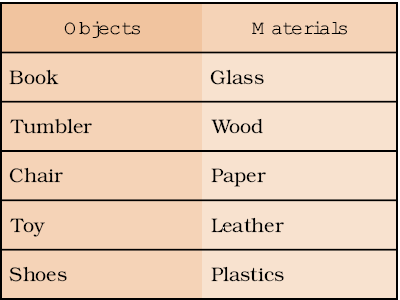
4. State whether the statements given below are True or False.
(i) Stone is transparent, while glass is opaque.
(ii) A notebook has lustre while eraser does not.
(iii) Chalk dissolves in water.
(iv) A piece of wood floats on water.
(v) Sugar does not dissolve in water.
(vi) Oil mixes with water.
(vii) Sand settles down in water.
(viii) Vinegar dissolves in water.
5. Given below are the names of some objects and materials:
Water, basket ball, orange, sugar, globe, apple and earthen pitcher
Group them as:
(a) Round shaped and other shapes
(b) Eatables and non eatables
6. List all items known to you that float on water. Check and see if they will float on an oil or kerosene.
7. Find the odd one out from the following:
a) Chair, Bed, Table, Baby, Cupboard
b) Rose, Jasmine, Boat, Marigold, Lotus
c) Aluminium, Iron, Copper, Silver, Sand
d) Sugar, Salt, Sand, Copper sulphate
Suggested Activity
1. You may have played a memory game with your friends. Several objects are placed on a table, you are asked to observe them for a few minutes, go into another room and write down the names of all objects that you can remember. Play this game, with a difference! Ask all the participants in the game to remember objects with some particular property while playing this memory game — remember and write down the names of objects that were made of wood or objects that are edible and so on. Have fun!
2. From a large collection of materials, make groups of objects having different properties like transparency, solubility in water and other properties. In later chapters you will also learn about properties of materials related to electricity and magnetism. After making different groups from the collected materials, try and find out if there are any patterns in these groups. For instance, do all materials which have lustre conduct electricity?
